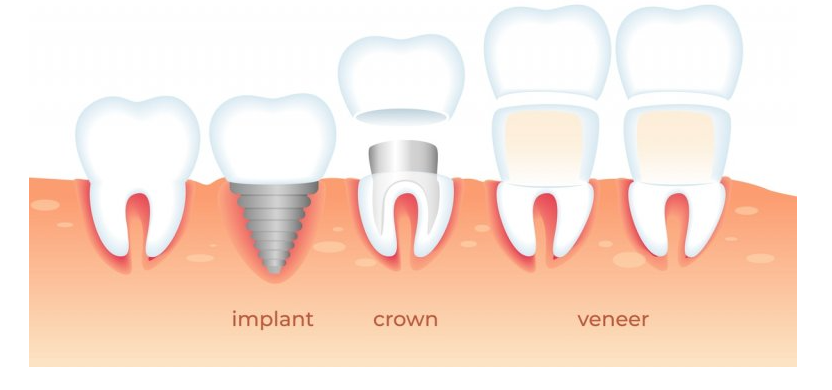What Are Veneers? Everything You Need to Know About This Common Dental Procedure


If you’re looking for a cosmetic solution for broken, chipped, discolored, or even misshaped teeth, then you’ll want to consider dental veneers. They are great options for people who are looking to improve their smile, with a minimally invasive procedure.
There are many factors to take into consideration when considering dental veneers, such as materials, after-care, and what other options are on the table.
But before you get ahead of yourself, you need to start with the basics: what are veneers?
Once you have the basics down, you can start to understand what your options are and make the best choice for your cosmetic dental needs.
This article will help you set a good foundation and cover everything you need to know about veneers to help you feel more prepared when bringing the subject up with your dentist.
Here’s a look at a few topics we’ll discuss:

Dental veneers are thin covers placed on the front surface of your teeth to provide a natural appearance. They provide you with a robust and resilient solution that acts similarly to your natural teeth — so you don’t have to give up the things you love.
Veneers are used to solve several cosmetic problems. Some of the most common problems include things like:
Dental veneers can help correct any of these cosmetic issues and leave you with a bright, full smile in just a few appointments.
Once placed, dental veneers are a permanent solution that can last for many years without breaking or discoloration when properly cared for. A veneer can break or become discolored over the years without the proper care.
Because veneers are long-term, permanent solutions, they should be considered an investment. They are not the cheapest solution to fixing tooth defects and may not have much insurance coverage.
The cost of veneers can range from $500 - $1,500 per tooth*, depending on the material and placement required. This cost can also vary based on where you live, and the brand your dentist uses, among other factors.
Some insurance companies will help cover the cost of veneers, but you’ll need to contact your insurance to understand your individual benefits better.
*General industry pricing only. See your local Aspen Dental for specific pricing.
While veneers are a great option to fix many cosmetic flaws, not everyone is a candidate to receive them. There are a few specific scenarios where someone may not be able to receive veneers.
Here are a few factors that may limit you from getting veneers:
If you have any of these conditions, you’ll want to speak with your dentist to learn more about whether or not veneers are an option for you. Each individual is different, and your case may still allow you to take advantage of the benefits of veneers.
Don’t be discouraged if your dentist determines you are not a candidate for veneers. There are many other options available, and your dentist can recommend the path that is the best for your needs.
There are two types of veneers that your dentist may recommend: direct bonding placement on the tooth or lab fabricated and cemented. Each type has its own pros and cons, but both will provide you with a fix for your dental needs.
When determining which type of veneer is best for your situation, you’ll want to speak with your dental provider. They can help you choose the veneer that fits within your expectations and budget constraints.
Porcelain veneers are strong, thin shells that are custom-made to fit the tooth. To attach this type of veneer, your dentist will need to remove a layer of your tooth’s enamel to place it.
The benefits of porcelain veneers include:
When it comes to cost factors, porcelain veneers are often the more expensive option and may be harder to replace if broken or damaged.
Composite resin veneers are made from a tooth-colored filling material that is then bonded to the tooth. Your dentist may still need to remove some of your tooth’s enamel to place this type of veneer, but it is less than the porcelain option.
The benefits of composite resin veneers include:
Composite resin veneers are cheaper than their porcelain counterparts, but they are also not as strong. This means they are more prone to breaking or wear and may need to be fixed more frequently.
Before we move on from the two types of veneers available, let’s take one more high-level comparison of the two options.
This chart gives you a quick view of the differences between the two options. Comparing the two side by side allows you to determine what’s most important to you.
If you’re looking for a high-quality solution that is strong, difficult to stain, and should last for years to come, porcelain may be a good option for you. On the other hand, if you’re looking for something a little less expensive that is easier to fix if it does break, you should consider composite resin veneers.
Speaking with your dental provider will help you decide which option is best for your situation. When having these conversations, make sure to let your dentist know about your expectations on the look of the final product, longevity, and price.
If you decide to move forward with the veneer process, there are a few steps you’ll have to go through. Veneers can generally be placed within one to two visits to your dentist, depending on the type you choose and the tooth it covers.
Porcelain veneers generally require one additional visit to the dentist because the veneer is sent out to a laboratory to be made. In contrast, composite resin veneers can often be done in one visit to your dentist.
Each type also has a slightly different bonding process — all of which we’ll cover below.
Here’s what you can expect from the veneer placement process from start to finish.
The very first step in the process is to have a consultation with your dentist.
During this visit, you will want to talk with your dentist about the problems you are experiencing and your expectations. This is a good time to let your dentist know if you have any budget constraints or are looking for something specific to be done.
Your dentist will then examine your teeth to ensure that veneers are an option for your situation and discuss the next steps for the procedure. It’s also likely that they will take X-rays and take a health scan of your mouth for treatment planning and diagnostic purposes during this visit.
To adhere the veneer to your teeth, there is some preparation is required.
During this step, your dentist will remove about half a millimeter of enamel from the front surface of the tooth. This allows the veneer to sit at the same level as your natural teeth and will keep it from looking out of place.
Depending on your needs and pain tolerance, you may have a local anesthetic to help numb the area while your dentist prepares it.
If you are having a composite resin veneer placed, this may be the last visit you need. They are placed right after the tooth has been prepared.
Porcelain veneers will require one additional visit. That is because your dentist will need to take a digital scan or impression of the tooth and have it sent out to a lab to be made. It can take about two to four weeks for your dentist to receive the veneers back.
Typically, a temporary veneer will be placed on the tooth during this time period.
Once your dentist has the veneers back from the lab, they will have you come in for the final step of the process, placement.
The last step required for this dental procedure is to place and adhere the veneers to your teeth.
To attach a composite resin veneer, your dentist will use a special light that will harden the composite and bond it to your teeth. They will then smooth and polish the veneer to make it look just like your natural teeth.
If you are having a porcelain veneer placed, this step will take place during the third visit to your dentist’s office once they’ve received the veneer from the laboratory.
Once the permanent veneers are ready, your dentist will place them on the teeth and check that the fit and shape are correct. They will then make any necessary adjustments, clean the teeth, and then bond them in place.
While having veneers placed is considered a dental procedure, it’s a minimally invasive procedure.
This means you should not experience any major pain or discomfort throughout the process. You may notice some sensitivity to temperature and slight soreness shortly after the veneers are placed — but that’s about it.
It may take a few days for you to get used to the way your new veneers feel, but it will become normal over time. But if you notice that your bite does not feel right after they are placed, let your dentist know so they can fix it before you leave the office.
After your final appointment, you should walk away with a beautiful smile with minimal to no post-procedure pain.
Due to the way veneers are placed, if your veneer needs to be replaced, you must replace it with a new one. So, it’s best to take proper care of your veneers from the start to ensure a longer lifespan.
For the most part, taking care of your veneers is very similar to the way you take care of your natural teeth. You should continue to brush your teeth at least twice a day, floss, and keep up with your routine dental visits.
Taking proper care of your oral hygiene will give you the best chance of keeping your smile white and defect-free for as long as possible. When done properly, your veneers will work well for years to come.
Of course, even with proper care, it is possible for your veneers to chip or crack. To avoid this from happening, you’ll want to make sure to take some additional precautions in your everyday life.
Some of these precautions you may want to take to make the most out of your veneers include:
Regardless of how well you care for your veneers, there will come a time when they need to be replaced. But practicing the right dental care can help to extend their timeline and allow you to get the most out of your investment.
Dental veneers are considered cosmetic dentistry, and not all general dentists offer these services. If your general dentist does not offer veneers, they will likely recommend a cosmetic dentist who can take your case.
If you’re looking to find a more cost-efficient option, dental school facilities are another option for having veneers placed. While these are less experienced students, they are always supervised by skilled dentists.
You’ve likely heard about some other common dental solutions such as crowns and implants and may be wondering what the differences between them are.

First, let’s start with veneers. Dental veneers are only designed to cover the front surface of your tooth. They are a thin layer that is placed on top of the part of the tooth you can see when looking in a mirror.
Dental veneers are not an option for covering or replacing the entire tooth and are much less invasive.
On the other hand, a crown is placed over the existing tooth, covering the entire tooth. When a crown needs to be placed, your dentist will need to grind down more of your tooth to prepare to place it.
This makes it more of an invasive solution, but it is a better option for patients who need to replace the entire crown of the tooth due to damage or decay.
Lastly, an implant is a replacement tooth that is installed directly into the jaw bone. Dental implants are used when a tooth, or teeth, are missing and need to be replaced.
Because this option is directly installed into your jaw bone, it is the most invasive of the three and requires much more work. But, implants are an excellent solution for someone who has missing teeth and is looking for a more natural-functioning than dentures or other tooth replacement options.
All of these dental procedures are great options to fix or replace your natural teeth. Determining which is the best option for you comes down to your specific needs.
Your dentist can help you determine what option is best for your situation and provide you with the guidance you need to make the best decision for you.
First and foremost, if you have a missing tooth or teeth, then a veneer won’t solve the problem. If this is the case, you will need to consider a dental implant or other replacement solutions like partial or dental bridges.
So it really comes down to whether or not your doctor prescribes a veneer or crown.
One of the main reasons people choose to go with veneers is that they require a less invasive procedure. They also offer a solution that lasts for an extended period of time and looks and feels just like your natural teeth.
But veneers have some limitations, specifically that they only cover the front of the tooth. That means if you have damage to the entire tooth, including the backside, then a crown would be the better solution for your needs.
Talk with your dental provider about what the best solution for you is. They can perform an oral exam and help you decide if veneers, crowns, or implants are the right choice for you.
Dental veneers are a great option for people who are looking to improve their smiles and gain their confidence back. If you’re looking for a minimally invasive way to fix some cosmetic flaws in your smile, then veneers or clear aligner therapy may be good solutions for your needs.
To determine whether they are the right choice for you, take the time to speak with your dental provider and get their opinion. They can guide you through the process, answer any questions, and take your specific needs into consideration.

Your new patient visit at Aspen Dental is our most important appointment together.